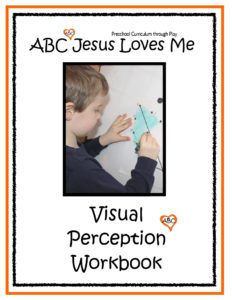
Hang around an Occupational Therapist or preschool teacher for a while and you will hear them say something about the midline. In our case, the therapist said, “Bubs is unable to cross the midline.” I assumed this was bad, but I didn’t know why or how to help the problem.
Crossing the Midline
Here is a definition of crossing the midline from the website ChildDevelopment.com.au.
The body’s mid-line is an imaginary line down the [center] of the body that divides the body into left and right. Crossing the body’s mid-line is the ability to reach across the middle of the body with the arms and legs. This allows children to cross over their body to perform a task on the opposite side of their body (e.g. being able to draw a horizontal line across a page without having to switch hands in the middle, sitting cross-legged on the floor or being able to insert puzzle pieces using the dominant right hand when the puzzle is placed on the left hand side of the body.
TheInspiredTreeHouse states that “If a child is able to cross the midline, it means that she is able to efficiently use and move the limbs of one side of the body in the space of the opposite side of her body.”
It sounds so basic but many children struggle with this developmental skill.

Why is Crossing the Midline Important?
As you can imagine, being unable to cross the midline affects basic activities both psychically and mentally.
Activities…
A child who has trouble crossing the midline can’t perform tasks that require their right hand to perform on the left side of their body and vice versa. It’s also difficult for them to perform a task that requires both hands to work together. This is because the two sides of the brain aren’t properly communicating with one another. Source: ILSLearningCorner.com
Handwriting…
If your child avoids crossing the midline, then both hands will tend to get equal practice at developing skills, and your child’s true handedness may be apparently delayed and fine motor skills may not be as good as they could be. One of the factors affecting handwriting is having a specialized, strong hand that does a good job of controlling the pencil. If both hands are being used equally, then your child may well end up with 2 mediocre hands rather than one strong, specialized hand. Source: OT-Mom-Learning-Activities.com
Motor Skills…
A child who is unable to cross the midline will struggle with both fine and gross motor skills. The coordination required for sports makes crossing the midline a requirement.
Reading…
Crossing the midline affects how a child reads as eye tracking from left to right is required.
Children who cannot cross the midline tend to hesitate or lose their place when their eyes shift from the words in front of the left side of the body to the words in front of the right side because doing so requires the two sides of the brain to communicate. Source: ILSLearningCorner.com
Self-care…
Every time that you tie your shoe, you are crossing the midline. Buttoning shirts and pulling down a sleeve requires a child to cross the midline.
But Isn’t Being Ambidextrous a Good Thing?
I often hear parents express with joy that their preschooler is ambidextrous. While this is considered a great things in sports, this may be a warning flag.
Children who have difficulty crossing midline may appear ambidextrous because they are often observed using both hands, but they actually have a hidden neuroprocessing issue. Both sides of their brains are not communicating, resulting in decreased coordination, decreased motor control of movements and difficulties achieving higher level skills. Often, these children end up with two unskilled hands. Source: NSPT4Kids.com

Crossing the Midline Activities
As early as birth, you can begin developing midline crossing skills in your child.
- When changing her diaper, touch her left toe to her right hand.
- Place toys across the midline to force the child to reach for them.
- Dance and touch your opposite elbow and knee.
- Give the child a car to drive around on roads made with painter’s tape.
- Play baseball and throw balls.
- Do windmills – Stand with your feet apart and arms extended to the sides. Bending at the wait, tap the right foot with the left hand. Stand back up and reverse with the right hand tapping the left foot.
 Visual Tracking activities help children follow the same line across a page. This is why Visual Perception Activities are included in the 4 and 5 Year Comprehensive Curriculum and we offer a Visual Perception Workbook to order.
Visual Tracking activities help children follow the same line across a page. This is why Visual Perception Activities are included in the 4 and 5 Year Comprehensive Curriculum and we offer a Visual Perception Workbook to order.
 Fine and Gross Motor Weekly Activities found in the ABCJLM 1-5 Year Curriculum will provide you with activities to encourage children to cross the midline.
Fine and Gross Motor Weekly Activities found in the ABCJLM 1-5 Year Curriculum will provide you with activities to encourage children to cross the midline.
More Information
This post is in no way exhaustive or to be used to diagnosis. Instead I hope that it will encourage you to provide your children with ample amounts of playtime to encourage them to cross the midline. And if you have more questions, be sure to talk to your pediatrician or an Occupational Therapist.

Why is there a growing problem with kids unable to cross the midline?
I believe one of the greatest reasons is because children don’t “play” anymore. They are given ample amount of screen and media time instead of playing on the floor with blocks, cars, and large pillows.
Is your child spending too much time using media? Check out this blog to see How Much Media Use is the Right Amount.
